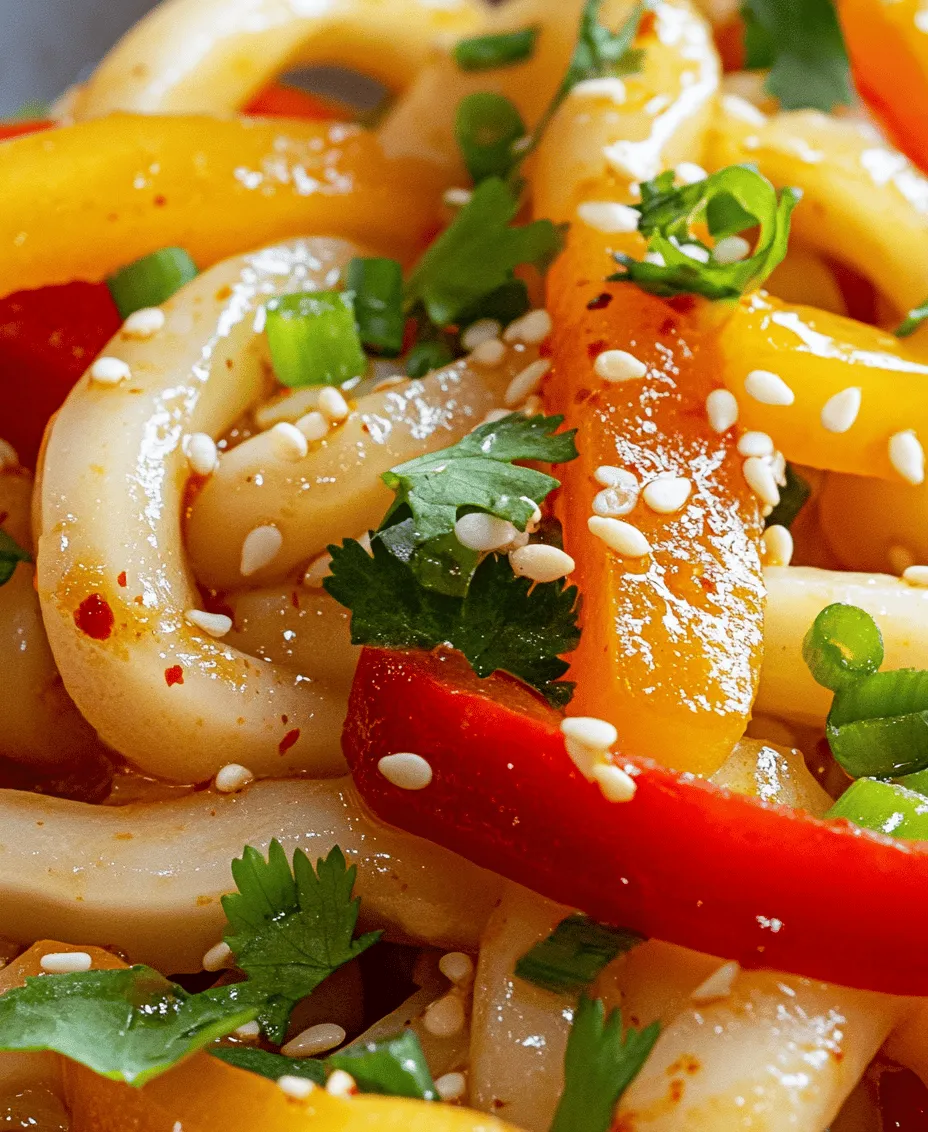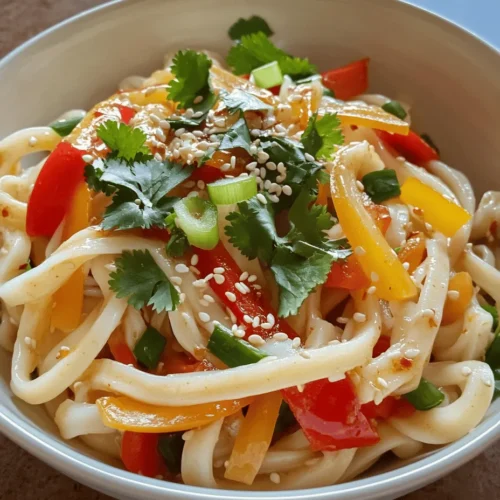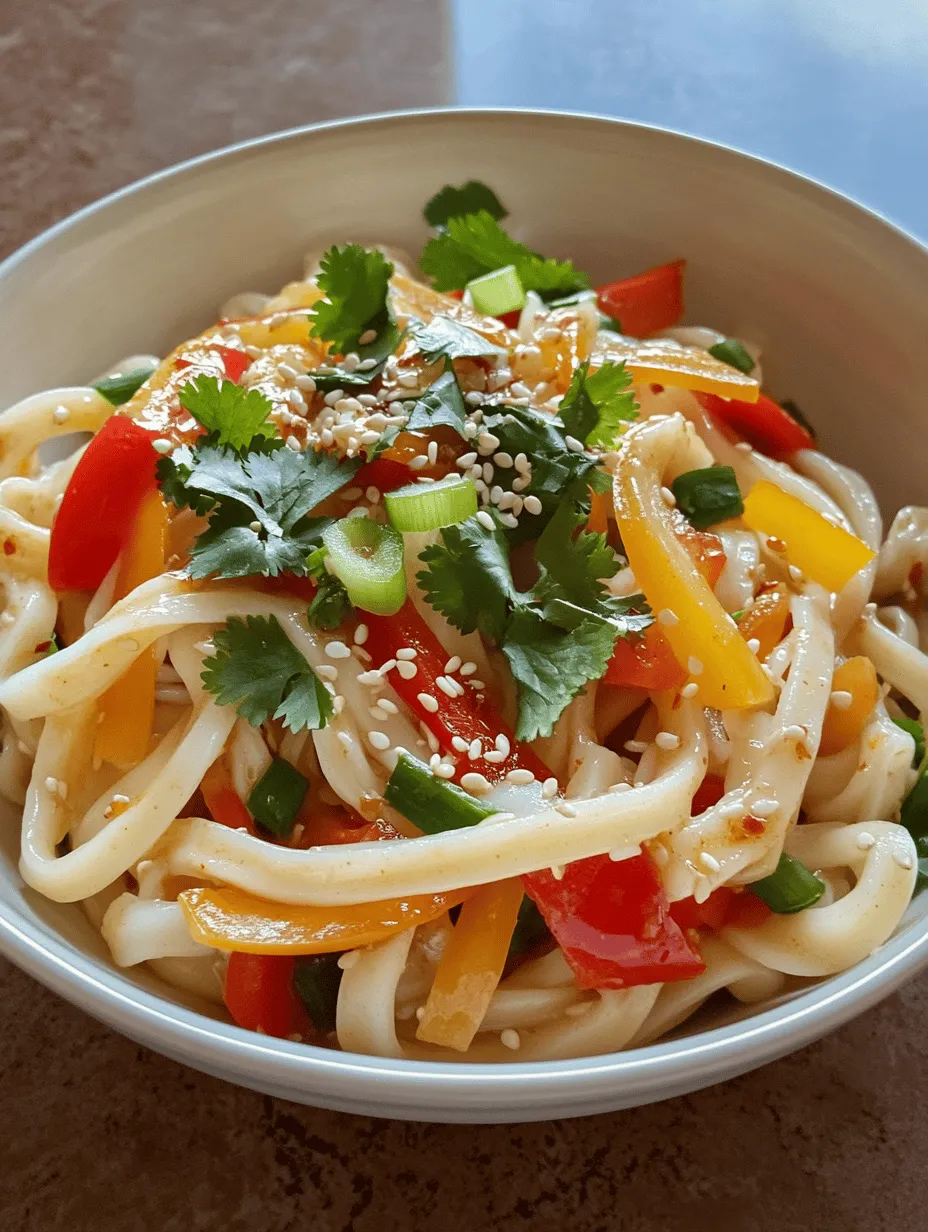Introduction
In today’s fast-paced world, where every minute counts, the quest for quick yet delicious meals has never been more important. Enter Spicy 10-Minute Chili Oil Udon Noodles, a dish that perfectly encapsulates this need. This vibrant and flavorful meal not only satisfies your hunger in mere minutes but also tantalizes your taste buds with a spicy kick. The combination of chewy udon noodles and aromatic chili oil creates a symphony of flavors that will impress even the most discerning palates.
Udon noodles, a staple in Japanese cuisine, are known for their thick, chewy texture and versatility. They can be enjoyed in a variety of dishes, from hot soups to cold salad preparations. With our Spicy 10-Minute Chili Oil Udon Noodles, you can experience the deliciousness of udon in a quick, flavorful way that suits your busy lifestyle.
Chili oil plays a pivotal role in this dish, infusing the udon noodles with heat and depth. Its bold flavor profile elevates the dish, creating a perfect balance of spice and umami. Whether you are a seasoned home cook or a culinary novice, this recipe is designed to deliver a satisfying meal with minimal effort.
The Allure of Udon Noodles
Udon noodles are a type of thick wheat noodle that originates from Japan. Their unique texture is what sets them apart; they are soft yet chewy, making them incredibly satisfying to eat. This distinctive mouthfeel is attributed to the way they are made—udon noodles are typically kneaded and rolled to achieve their characteristic thickness.
Nutritionally, udon noodles are a great source of carbohydrates and provide energy for your day. While they may not be as high in protein as some other noodle varieties, they do offer a comforting base for a variety of toppings and sauces, making them a versatile choice for many dishes.
Culturally, udon holds a special place in Japanese cuisine. It is often enjoyed in traditional dishes such as kake udon (udon in broth), yaki udon (stir-fried udon), and bukkake udon (cold udon served with a dipping sauce). When compared to other noodle types, such as soba and ramen, udon’s thick and chewy texture is unique. Soba noodles, made from buckwheat, are thinner and have a nuttier flavor, while ramen noodles are often curly and have a firmer bite thanks to their alkaline composition.
The versatility of udon makes it an excellent canvas for a variety of flavors and preparations, allowing it to shine in both simple and complex dishes alike.
Chili Oil: A Flavorful Essential
Chili oil is a staple condiment in many Asian cuisines, adding a layer of heat and richness to dishes. It is typically made from a blend of oil infused with dried chili peppers, garlic, and sometimes additional spices. The result is a fragrant oil that brings a delightful kick to your meals.
There are two primary types of chili oil: store-bought and homemade. While store-bought options are convenient, making your own chili oil allows for greater customization in terms of spice level and additional flavors. Homemade chili oil can be tailored to your personal taste, ensuring that every drop packs the perfect amount of heat.
In addition to its robust flavor, chili oil also boasts several health benefits. It contains capsaicin, the compound responsible for the heat in chili peppers, which is known for its potential anti-inflammatory properties. Using chili oil in moderation can add excitement to your meals while also delivering some health perks.
When selecting chili oil, it’s important to choose a high-quality product that uses fresh ingredients. Look for oils that have a rich, vibrant color and a balanced flavor profile. The right chili oil can make all the difference in elevating your Spicy 10-Minute Chili Oil Udon Noodles to new heights.
Ingredient Breakdown
To prepare Spicy 10-Minute Chili Oil Udon Noodles, you will need a few key ingredients. Each component plays a crucial role in creating the flavor and texture of the dish.
Udon Noodles
The heart of this dish is the udon noodles. Available in both fresh and dried forms, they can be found in most grocery stores or Asian markets. Fresh udon noodles cook quickly, typically requiring only a few minutes in boiling water. Dried udon noodles, while slightly longer to prepare, yield the same delicious results. Look for brands that offer a chewy texture, as this is what makes udon noodles so appealing.
Chili Oil
As mentioned earlier, chili oil is essential for this recipe. Depending on your spice tolerance, you can choose a milder or hotter variety. If you’re feeling adventurous, consider making your own chili oil by infusing neutral oil with your choice of dried chilies, garlic, and other spices. This not only enhances the flavors but also ensures you’re using fresh ingredients.
Garlic
Garlic adds a fragrant aroma and depth of flavor to the dish. It can be used fresh, minced, or even roasted to create a sweeter, more mellow taste. Beyond its flavor-enhancing properties, garlic is celebrated for its numerous health benefits, including its potential to boost the immune system and provide anti-inflammatory effects.
Soy Sauce
Soy sauce is a staple in Asian cooking, providing a salty, umami-rich flavor that complements the udon noodles beautifully. There are several types of soy sauce, including light, dark, and tamari (a gluten-free option). Each variety brings a different flavor profile, so choose one that fits your preference. Light soy sauce is saltier and is often used for seasoning, while dark soy sauce is thicker and sweeter, perfect for adding color and richness.
Sesame Oil
Sesame oil contributes a nutty aroma and flavor that enhances the overall profile of the dish. It is typically used sparingly due to its strong flavor, and a little goes a long way. Toasted sesame oil, in particular, brings an extra layer of depth to your udon noodles.
Rice Vinegar
Rice vinegar adds a touch of acidity that balances the richness of the chili oil and soy sauce. Its mild flavor profile complements the other ingredients without overpowering them. A splash of rice vinegar can elevate the dish, providing a refreshing contrast to the heat.
Sugar
While it may seem unusual to include sugar in a savory dish, it plays an important role in flavor balancing. Sugar helps to round out the heat from the chili oil and the saltiness from the soy sauce, creating a harmonious blend of tastes. Use a small amount to start and adjust to your preference.
Green Onions and Sesame Seeds
Finally, green onions and sesame seeds provide the finishing touch to your Spicy 10-Minute Chili Oil Udon Noodles. Green onions add a fresh crunch and a pop of color, while sesame seeds contribute a delightful texture and nuttiness. Together, they enhance both the visual appeal and the overall taste of the dish.
With this well-rounded list of ingredients, you are well on your way to creating a delicious and satisfying meal. In the next steps, we will guide you through the process of preparing and cooking your Spicy 10-Minute Chili Oil Udon Noodles, ensuring that you achieve the perfect balance of flavors and textures. Stay tuned as we dive into the cooking instructions that will have you enjoying this delightful dish in no time!

Optional Ingredients: Fresh Vegetables and Cilantro for Added Nutrition
While the basic recipe for Spicy 10-Minute Chili Oil Udon Noodles is delicious on its own, adding fresh vegetables and herbs can enhance both the nutritional profile and the overall flavor. Consider incorporating ingredients such as sliced bell peppers, carrots, broccoli, or snap peas for a crunchy texture and vibrant color. A sprinkle of fresh cilantro or green onions on top not only adds a burst of freshness but also elevates the dish aesthetically. These optional ingredients can be easily customized based on your preferences or what you have available.
Step-by-Step Guide to Preparing Spicy Chili Oil Udon Noodles
Cooking the Udon Noodles
1. Boiling and Rinsing the Noodles
Start by bringing a large pot of salted water to a boil. Once boiling, add the udon noodles. Fresh udon noodles typically require about 2-3 minutes to cook, while dried noodles may need 5-7 minutes. The goal is to achieve a texture that is firm yet tender—this is known as al dente.
2. Importance of Texture: Al Dente vs. Overcooked
Cooking the noodles to al dente is crucial. If overcooked, the noodles can become mushy and lose their delightful chewiness, which is a hallmark of udon. To test the noodles, taste a strand a minute or two before the package instructions suggest.
Once cooked, immediately drain the noodles in a colander and rinse them under cold water. Rinsing stops the cooking process and removes excess starch, preventing the noodles from clumping together.
Crafting the Sauce
3. Mixing the Sauce Ingredients
In a mixing bowl, combine essential ingredients to create the spicy chili oil sauce. Start with soy sauce, which provides a savory umami base. Add chili oil for heat; you can find this in most grocery stores or make your own by infusing oil with chili flakes. Then, mix in a splash of rice vinegar for acidity and a touch of sugar to balance the flavors.
4. Tips for Adjusting Spice Levels to Personal Preference
Spice tolerance varies from person to person, so feel free to adjust the amount of chili oil to suit your palate. For those who enjoy milder flavors, start with a teaspoon of chili oil and gradually increase it until you reach your desired heat level.
5. Importance of Balancing Flavors
The key to a well-rounded sauce lies in balancing flavors. The salty soy sauce, spicy chili oil, tangy rice vinegar, and a hint of sweetness from sugar create a harmonious blend. Taste your sauce before mixing it with the noodles, and make adjustments as needed. This might mean adding more vinegar for acidity or sugar for sweetness, depending on your personal preference.
Combining Noodles and Sauce
6. Techniques for Effectively Coating the Noodles
Once your noodles are rinsed and your sauce is mixed, it’s time to bring the two together. In a large mixing bowl, add the drained udon noodles and pour the sauce over them. Use tongs or chopsticks to gently toss the noodles in the sauce. This method ensures that every strand is evenly coated without breaking the delicate noodles.
7. Suggestions for Serving Temperature: Warm vs. Room Temperature
Spicy chili oil udon noodles can be enjoyed warm or at room temperature. If you prefer a warm dish, you can heat the noodles slightly in a pan for a minute before adding the sauce. For a refreshing summer meal, let the noodles cool to room temperature and serve.
Plating and Presentation
8. Guidelines for Garnishing with Green Onions, Sesame Seeds, and Optional Vegetables
The final step in preparing your dish is presentation. Transfer the coated noodles onto a plate or in a bowl. For an appealing look, garnish with sliced green onions, sesame seeds, and any optional vegetables you decided to add. This not only enhances the dish visually but also adds texture and flavor.
9. Importance of Visual Appeal in Food Presentation
Food presentation is an essential part of the dining experience. A well-plated dish can make even simple ingredients look gourmet. Consider using contrasting colors and varying heights when garnishing to create an inviting plate that will impress your guests.
Nutritional Information
Breakdown of Calories and Macronutrients Per Serving
A serving of Spicy 10-Minute Chili Oil Udon Noodles typically contains approximately 400-450 calories, depending on the amount of sauce and any additional ingredients used. The calorie breakdown is roughly 60% carbohydrates from the udon noodles, 20% fats from the chili oil, and 20% protein, primarily from soy sauce and any protein-rich vegetables you add.
Discussion of Health Aspects
While this dish is delicious, it’s also adaptable for various dietary needs. For those looking for gluten-free options, substitute traditional udon noodles with rice noodles or gluten-free udon alternatives. Additionally, using low-sodium soy sauce can help reduce sodium intake without sacrificing flavor.
Serving Suggestions and Pairings
Ideas for Side Dishes and Beverages
To enhance your meal, consider serving your spicy udon noodles with side dishes such as steamed edamame, a light cucumber salad, or miso soup. These options complement the flavors of the noodles while providing additional nutrition.
For beverages, a chilled green tea or a light Japanese lager pairs well with the spice of the dish, refreshing your palate.
Cultural Context: How This Dish Fits Into a Larger Japanese Meal
In Japanese cuisine, noodles often play a central role, either as a main dish or as part of a larger meal. Spicy udon noodles can be served as an alternative to traditional ramen or soba, offering a different texture and flavor profile. This dish can also be enjoyed as a quick lunch or a casual dinner, reflecting the Japanese ethos of simple yet satisfying meals.
Conclusion
Spicy 10-Minute Chili Oil Udon Noodles are a testament to the beauty of quick cooking without sacrificing flavor. This dish is not only easy to prepare but also allows for creativity with ingredients and personal touches. Whether you prefer it spicy, tangy, or simply savory, this recipe invites you to explore and adapt it to your taste.
As you dive into cooking, remember that the joy of preparing meals lies in experimentation. Enjoy the process, and don’t hesitate to make this dish your own. Embrace the art of cooking quick, flavorful meals that satisfy both your hunger and your palate. Happy cooking!



